Country
Crash of an ATR72-212 in Cox's Bazar
Date & Time:
Jul 20, 2014 at 1745 LT
Registration:
S2-AFN
Survivors:
Yes
Schedule:
Dhaka - Cox's Bazar
MSN:
379
YOM:
1993
Flight number:
4H501
Crew on board:
5
Crew fatalities:
Pax on board:
43
Pax fatalities:
Other fatalities:
Total fatalities:
0
Circumstances:
Following an uneventful flight from Dhaka, the crew initiated the approach to Cox's Bazar in poor weather conditions due to heavy rain falls. After touchdown, the nose gear collapsed. The airplane slid on its nose for few dozen metres before coming to rest in the middle of the runway that was blocked for almost 22 hours. All 48 occupants evacuated safely while the aircraft was damaged beyond repair.
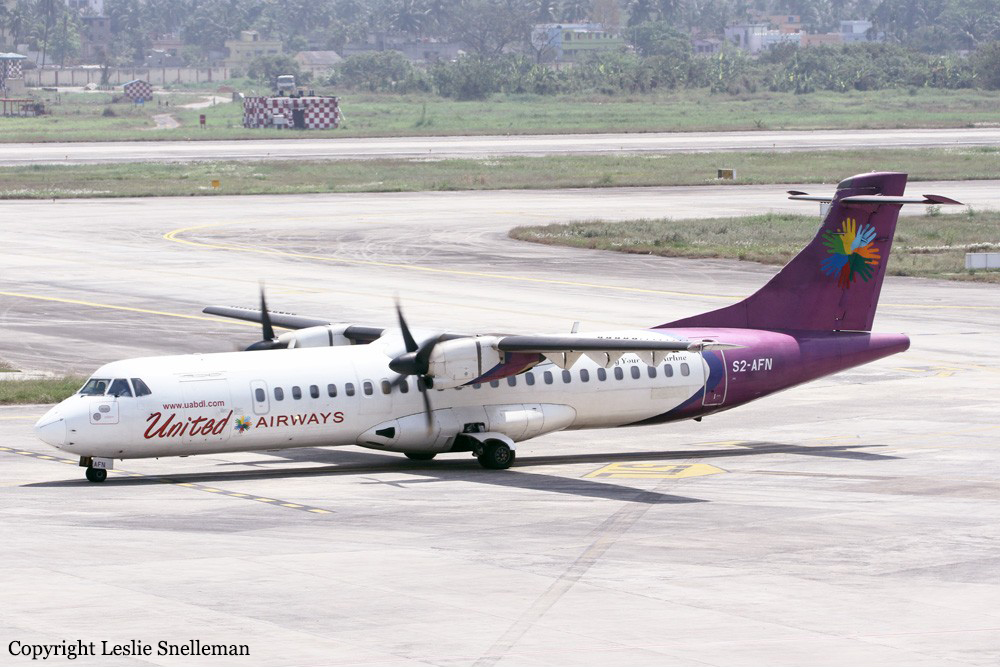
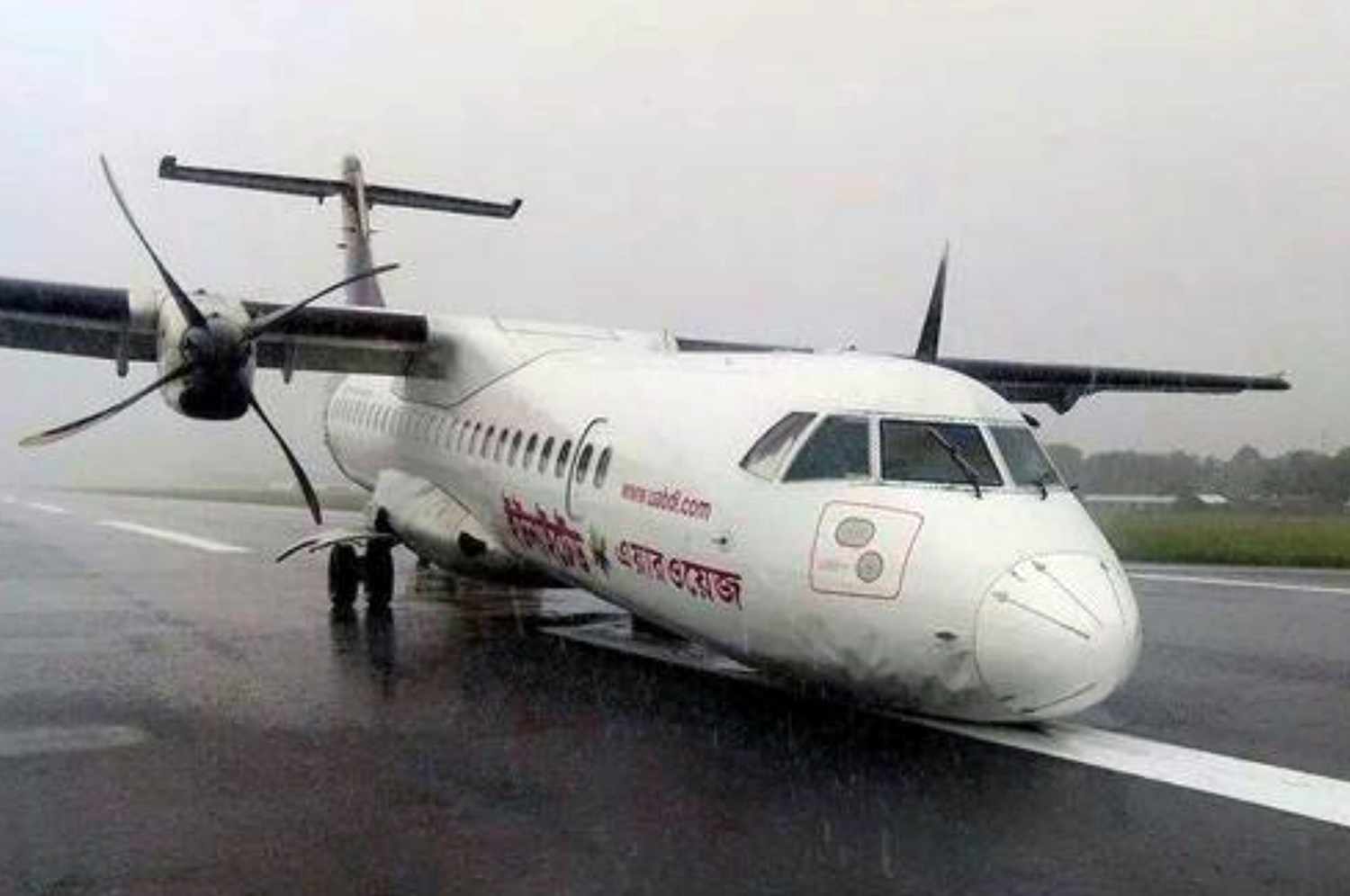
Crash of an ATR72-201 in Tyumen: 33 killed
Date & Time:
Apr 2, 2012 at 0735 LT
Registration:
VP-BYZ
Survivors:
Yes
Schedule:
Tyumen - Surgut
MSN:
332
YOM:
1992
Flight number:
UT120
Crew on board:
4
Crew fatalities:
Pax on board:
39
Pax fatalities:
Other fatalities:
Total fatalities:
33
Captain / Total hours on type:
2522.00
Copilot / Total hours on type:
1765
Aircraft flight hours:
35523
Aircraft flight cycles:
49663
Circumstances:
On 01.04.2012 the the UTAir Air Division 1 crew (based at Surgut AP) was conducting a scheduled passenger flight UTA-119 on the АТR 72-201 VP-BYZ A/C from Surgut to Tyumen. The landing at Tyumen (Roschino) AP was performed at 17:41 (23:41 local time). Descending for landing at Roschino (Tyumen) AD was conducted in extended cloudiness with icing conditions. According to the FDR records, the flight crew used the aircraft ice protection system. At the time of flight UTA-119 landing at Roschino (Tyumen) AD the weather was as follows: surface wind 090°-7 m/s, visibility 1600 m, showers of moderate snow with rain, significant cumulonimbus (5-7 oct.) clouds, fractonimbus, cloud base at 140 m, temperature + 0.2°C, dew point + 0.2°C, QFE 735 mmhg (980 hPa), friction coefficient 0.6; moderate icing at cloud layer from 140 m to 4800 m. Forecast for landing: tempo visibility 500 m, showers of heavy snow with rain, vertical visibility 90 m. Weather at Roschino (Tyumen) AD at day time on 01.04.2012 and at night from 01.04.2012 to 02.04.2012 was formed by the cyclone trough forward part with the widespread precipitation area associated with warm front. A passage of the warm front through Roschino (Tyumen) AD was expected in the period from 20:00 to 21:00, with a temperature of 0°C and relative humidity 100% precipitations were fallen from the cumulonimbus and fractonimbus clouds in form of showers of snow with rain. Visibility in precipitations was 1200–1600 m with individual charges of heavy wet snow with visibility 600–700 m and vertical visibility 100 m. Precipitation was followed by east wind 9–10 m/s, direction 90–110°, with individual gusts up to 13–14 m/s. This direction of wind remained till 21:00. After the passage of front through the region of Roschino (Tyumen) AD, at 21:05 the surface wind changed its direction to the west 250° – 260° with gradual increase of wind speed from 2–4 m/s to 7–10 m/s. Precipitation in the form of showers of moderate snow with rain at Roschino (Tyumen) AD went on till 22:00, 01.04.2012. From 22:00, 01.04.2012 to 01:00, 02.04.2012 precipitation turned into showers of slight snow with rain with a temperature of 0°C and relative humidity 100%. According to the observations of weather stations situated at a distance of about 200– 250 km from Roschino (Tyumen) AD and affected by the cyclone on 01.04.2012 as well as on 02.04.2012 storm detecting information was sent to the Roschino (Tyumen) AD AMC about glaze-ice accretion of wet snow. After the landing the A/C was placed at stand 3 heading to the air terminal (MH 30°). According to the flight shift work schedule, the crew left for rest to the Liner Hotel at Roschino AP and had a rest till 23:30 (05:30 local time). After having their rest, the crew members arrived to the AP and started the preflight preparation for the UTA120 scheduled passenger flight from Tyumen to Surgut with visiting AMC where at 00:15 they got weather briefing and documentation. The Nizhnevartovsk AD had been appointed as the alternate AP. At the end of the weather briefing the PIC received Form АВ-11 No.1 and put his signature at the sheet of the "Log of flight crews’ weather briefings at Tyumen-Roschino AMC" indicating the flight number and the A/C number. The weather forecast and actual weather at the departure AD, destination AD and alternate AD as well as their technical conditions did not imply any hazard for the flight operation. At 00:20 the crew passed a medical examination at the AP pre-start medical station and was cleared for the flight. According to the intra-airport radio conversation, around the same time the PIC made his decision to fly. After the medical examination, the F/O visited the aeronautical information office and received a navigator’s briefcase and flight plan; which is recorded in pertinent logbooks. Further, the crew continued the preflight preparation in the briefing room. According to the load documents there were 39 passengers, 133 kg of cargo, 143 kg of passengers’ luggage, and 1 kg of mail registered for the UTA120 flight. The fuel on board was 2000 kg, the A/C TOW was 18730 kg, the A/C weight balance was 30.72% mean aerodynamic chord. The TOW and weight balance were inside the AFM (FCOM) limitations. According to an avionics technician's statements the crew arrived to the A/C around 00:30. By the external observation video camera records it can be seen that the PIC performed the preflight inspection very briefly. He lingered for a few minutes by the right engine then moved along the fuselage sides, then stopped by the left main gear, and finally went into the cockpit. The after-inspection FTLB entry made by the PIC was: "LC PERFORMED BY CDR", the PIC also put the time of inspection which was 00:40 and quantity of fuel 2000 kg. There were no remarks made against the A/C condition in the FTLB. By the records of the external observation video camera, it can be seen that at 01:13 the boarding had been completed and the entrance door was closed. So, the A/C had been remaining at the AD under the influence of precipitations in the form of rain and wet snow with ambient temperature around zero degrees Celsius and wind velocity more than 10 m/s for more than 7 hours. There was no de/anti-icing treatment performed for the A/C before the flight. At 01:20 the flight crew performed the engine start, and after that passed through the Before Taxi checklist. At 01:24:46 the flight crew obtained clearance for holding position. At 01:32:08 after clearance for lineup position the flight crew reported: “Lining up”. At 01:32:58 the A/C started taking off. The takeoff was performed with flaps extended at 15°. The A/C lift-off occurred at 01:33:28 with a speed of around ≈127 kt. At 01:33:56 at height 600 ft2 and speed of 135 kt the A/P was engaged. At 01:34:00 at height 640 ft and speed of 139 kt the flaps retraction was started. At 01:34:08 after the retraction had been completed, at 690 ft and at a speed of 150 kt uncommanded development of right bank started. At 01:34:10 the A/P was disengaged. The bank angle reached around 40° to the right within 3 s and after that was counteracted by ailerons and rudder deflection. Further, the A/C banked to the left, which the flight crew was not able to compensate with full deflection of ailerons to the right. The A/C collision into terrain occurred at 01:34:35 with a pitch down angle ≈11°, left bank angle ≈55° and vertical rate of descent over 20 m/s. The ASL elevation of the accident area is about ≈110 m. The accident resulted in the A/C full destruction and partial damage by the ground fire. From the 43 persons onboard 4 crew members and 29 passengers were killed. Others sustained serious injuries.
Probable cause:
The immediate cause of the АТR 72-201 VP-BYZ aircraft accident was the PIC’s decision to takeoff without de/anti-icing treatment despite the fact that snow and ice deposits were present on aircraft surface and were discovered by the crew members during taxi which resulted in degradation of aircraft aerodynamic performance and stall during climbing after takeoff as well as inability of the crew to recognize stall and, consequently, failure to undertake recovery procedure. The aircraft stall occurred at the operational angles of attack right after flaps retraction with engaged autopilot before stall warning system activation and was caused by the loss of the wing lift effectiveness due to takeoff with non-removed ground icing. The system cause of the accident were shortcomings in ground handling activities and staff training in UTAir-Technik that became possible because of absence of due monitoring by the Technical and Operation Supervising Directorates of UTAir airline for compliance with airline requirements regarding ground handling and aircraft ground icing protection which resulted in erroneous evaluation of aircraft conditions by the PIC and aircraft mechanic (the shift head kept himself aloof from monitoring mechanic’s activities) after the aircraft has been on ground in icing conditions for a long time and in release the aircraft to fly without de/anti-icing treatment.
The contributing factors were:
- The shortcomings in the UTAir safety management system, which contains, all in all, general issues only and is not adopted for the implementation of Airline activities in particular areas, which did not allow to reveal and correct existing safety risks in a timely manner.
- The shortcomings in the UTAir-Technic quality management system, resulted in neglecting of certain requirements of the UTAir ground handling management manual regarding staff training and monitoring for aircraft de/anti-icing treatment which led to the situation when not sufficiently-qualified staff performed the evaluation of the aircraft surface conditions and made the decision on need for the aircraft to be de-iced/anti-iced.
- The absence at the time of the accident of basic regulations in force that establish state requirements for ground handling (de/anti-icing treatment in particular) including staff training and organization licensing.
- The shortcomings in crew members initial and recurrent training as far as the danger of ground icing, its influence on the aircraft aerodynamic performance together with aircraft anti-icing system operation features and design are concerned that did not allow the crew to make the only appropriate decision to return for de-icing/anti-icing treatment after the observation of the snow and ice contamination on the wing after anti-icing system activation in de-icing mode while taxiing for takeoff.
- The methodological imperfection of the crew computer based and simulator training programs concerning the prevention of aircraft stall, identification of approach to stall and taking timely actions for recovery.
- The increasing need for number of flight crews to perform highly growing flights schedule which, with ineffective SMS, resulted in flight instructor work deficiencies during PIC training and absence of PIC skills to take correct decisions and to strictly comply with the regulations in force.
- The possible fatigue of the crew members due to the violation of the work and rest balance while performing split flight shifts together with a large number of unused days-off.
The contributing factors were:
- The shortcomings in the UTAir safety management system, which contains, all in all, general issues only and is not adopted for the implementation of Airline activities in particular areas, which did not allow to reveal and correct existing safety risks in a timely manner.
- The shortcomings in the UTAir-Technic quality management system, resulted in neglecting of certain requirements of the UTAir ground handling management manual regarding staff training and monitoring for aircraft de/anti-icing treatment which led to the situation when not sufficiently-qualified staff performed the evaluation of the aircraft surface conditions and made the decision on need for the aircraft to be de-iced/anti-iced.
- The absence at the time of the accident of basic regulations in force that establish state requirements for ground handling (de/anti-icing treatment in particular) including staff training and organization licensing.
- The shortcomings in crew members initial and recurrent training as far as the danger of ground icing, its influence on the aircraft aerodynamic performance together with aircraft anti-icing system operation features and design are concerned that did not allow the crew to make the only appropriate decision to return for de-icing/anti-icing treatment after the observation of the snow and ice contamination on the wing after anti-icing system activation in de-icing mode while taxiing for takeoff.
- The methodological imperfection of the crew computer based and simulator training programs concerning the prevention of aircraft stall, identification of approach to stall and taking timely actions for recovery.
- The increasing need for number of flight crews to perform highly growing flights schedule which, with ineffective SMS, resulted in flight instructor work deficiencies during PIC training and absence of PIC skills to take correct decisions and to strictly comply with the regulations in force.
- The possible fatigue of the crew members due to the violation of the work and rest balance while performing split flight shifts together with a large number of unused days-off.
Final Report:
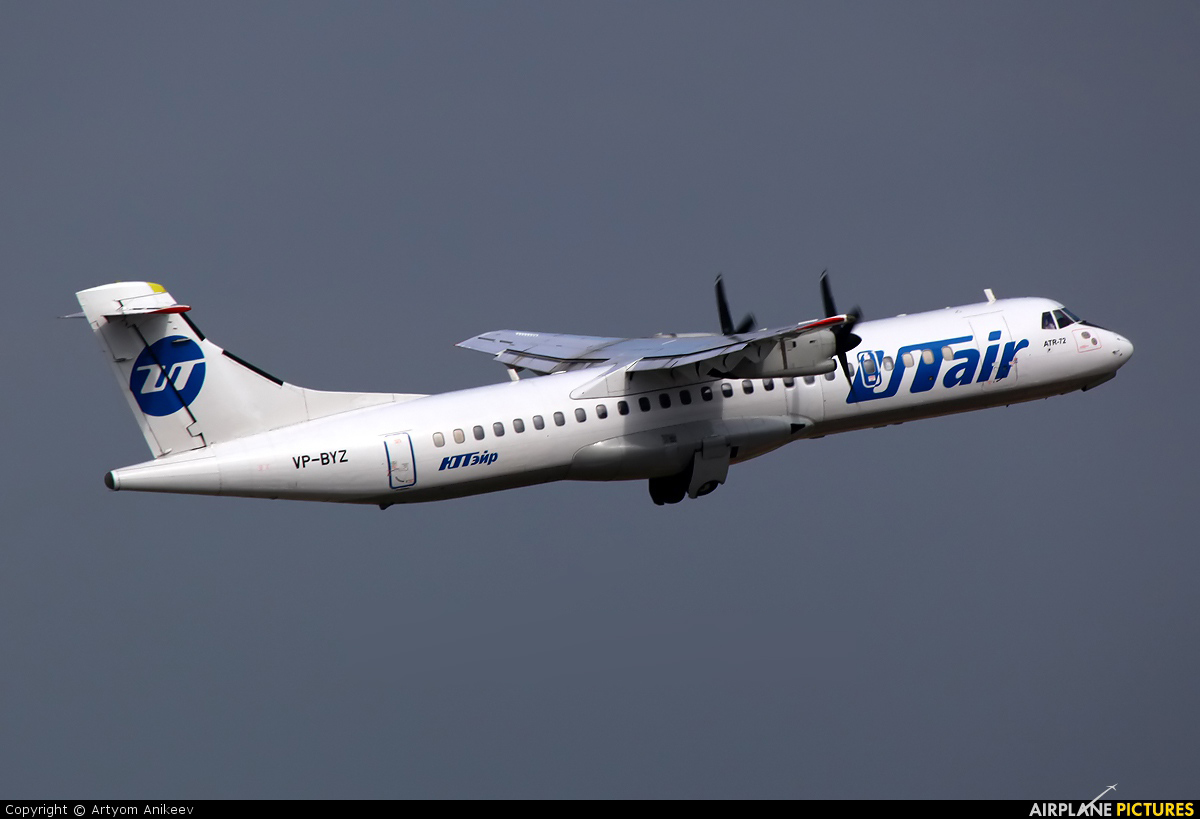
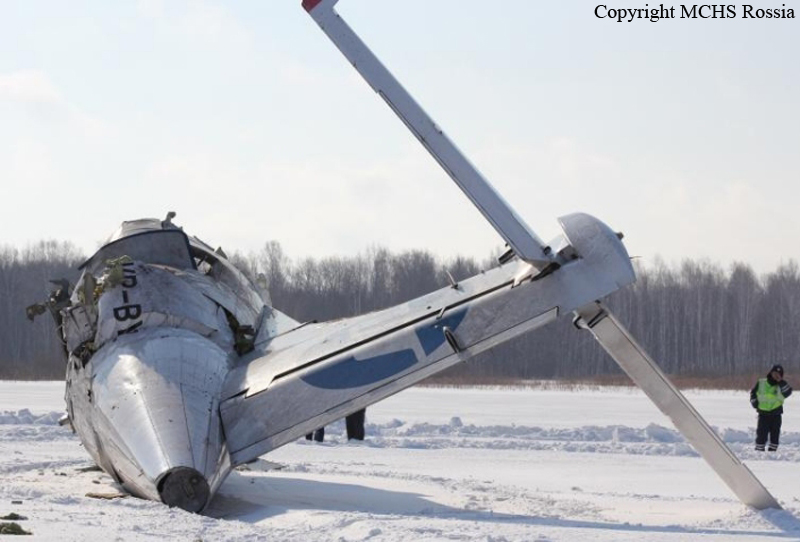
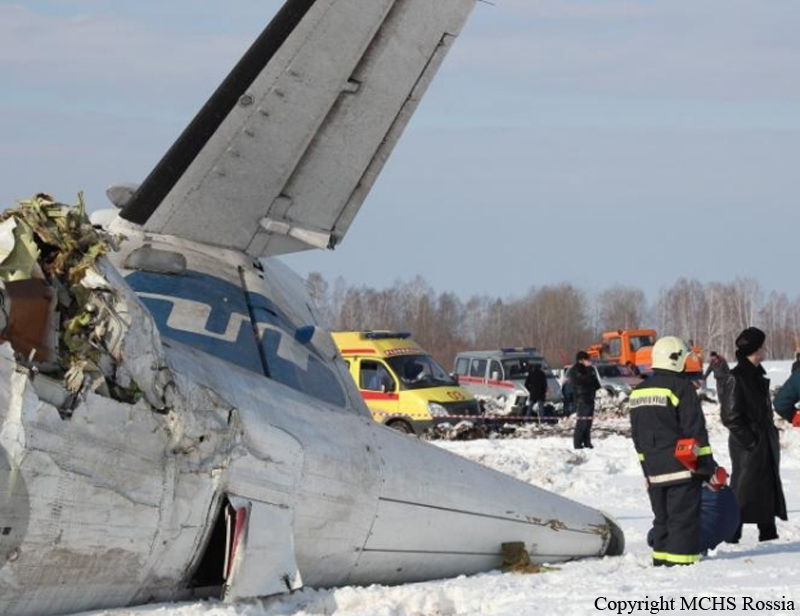
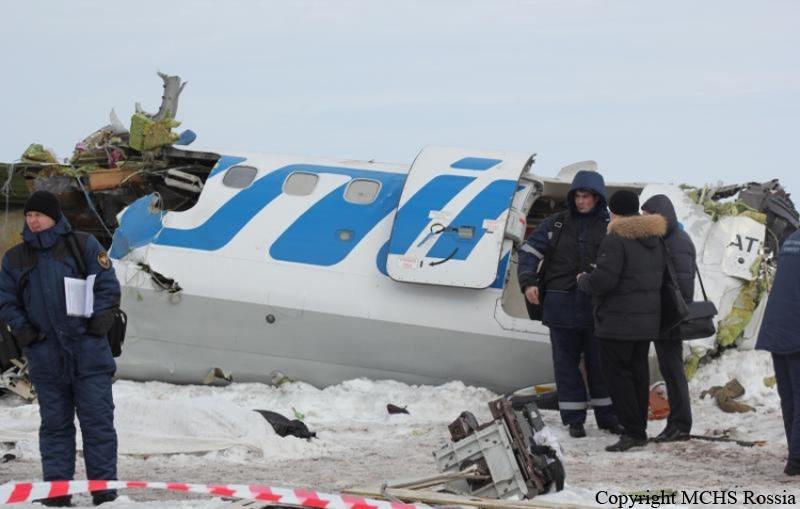
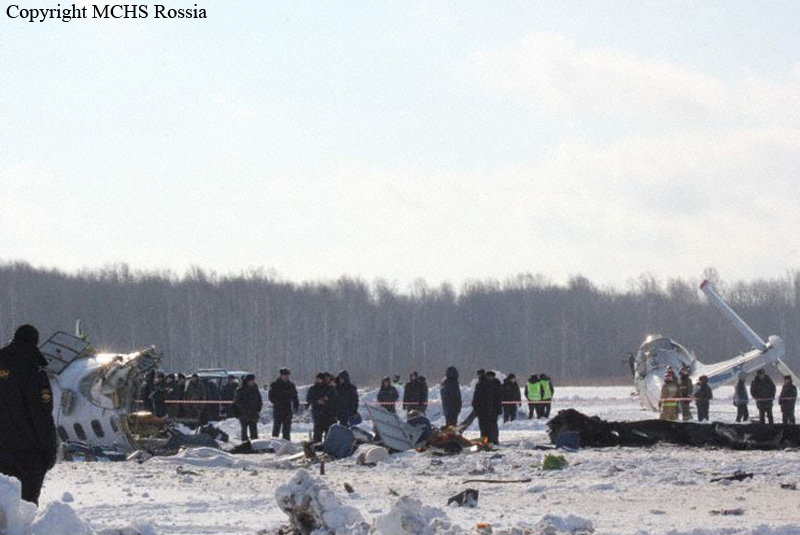

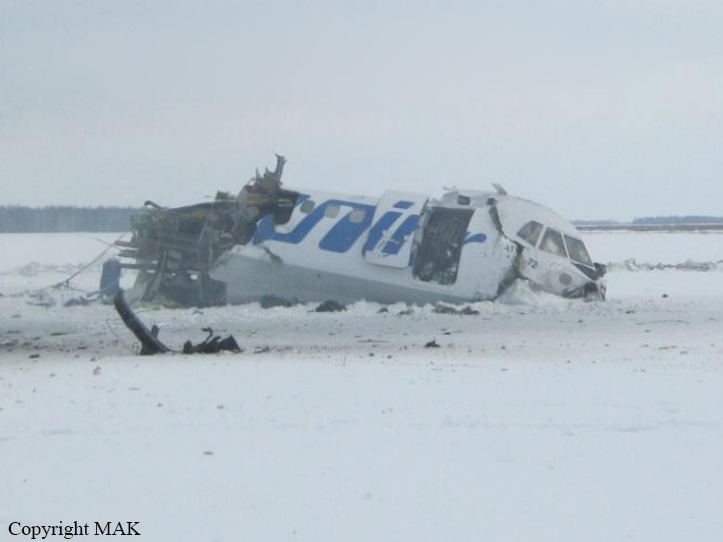



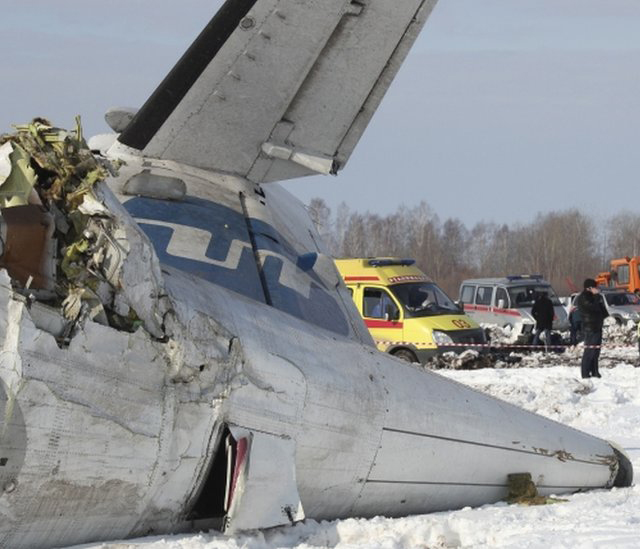

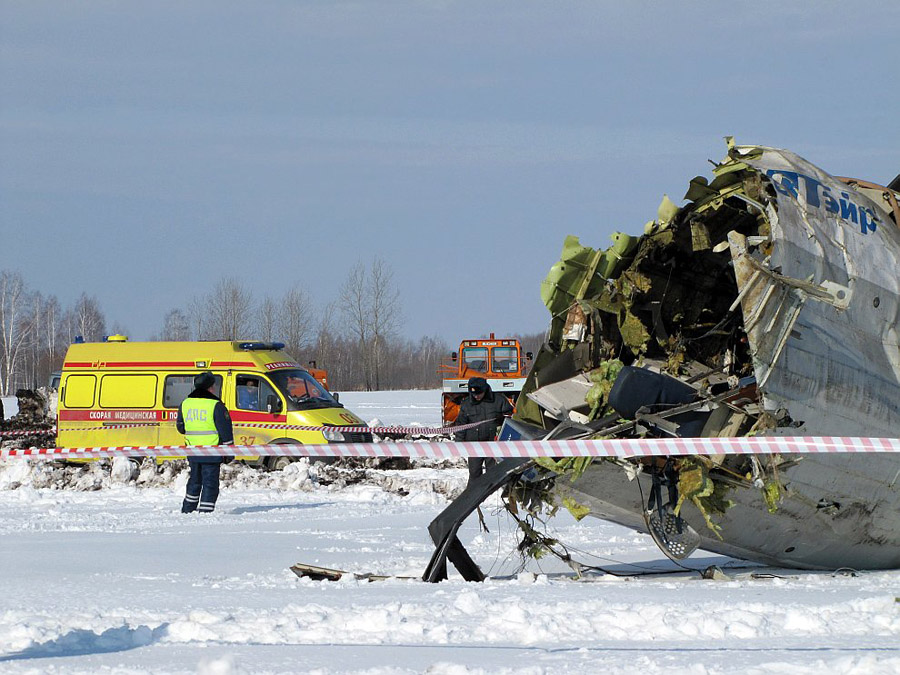

Crash of an ATR72-212 in Shannon
Date & Time:
Jul 17, 2011 at 1021 LT
Registration:
EI-SLM
Survivors:
Yes
Schedule:
Manchester - Shannon
MSN:
413
YOM:
1994
Flight number:
EI3601
Crew on board:
4
Crew fatalities:
Pax on board:
21
Pax fatalities:
Other fatalities:
Total fatalities:
0
Captain / Total hours on type:
2444.00
Copilot / Total hours on type:
1351
Aircraft flight hours:
32617
Aircraft flight cycles:
37149
Circumstances:
The aircraft and crew commenced operations in EINN that morning, departing at 05.52 hrs and arriving at EGCC at 07.13 hrs. During the turnaround, fuel was uplifted and 21 passengers boarded. Using the flight number and call sign EI-3601 the scheduled passenger service departed EGCC at 07.47 hrs for EINN with an estimated flight time of one hour and nine minutes. En-route operations were normal and, in consultation with ATC, the aircraft descended and was cleared to self-position to DERAG2 for an Instrument Landing System (ILS) approach to RWY 24. At 09.08 hrs the aircraft commenced an approach to RWY 24 in strong and gusty crosswind conditions. Following a turbulent approach difficulty was experienced in landing the aircraft, which contacted the runway in a nose-down attitude and bounced. A go-around was performed and the aircraft was vectored for a second approach. During this second approach landing turbulence was again experienced. Following bounces the aircraft pitched nose down and contacted the runway heavily in a nose down attitude. The nose gear collapsed and the aircraft nose descended onto the runway. The aircraft sustained damage with directional control being lost. The aircraft came to rest at the junction of the runway and a taxiway. Following engine shutdown the forward Cabin Crew Member (CCM) advised the cockpit that there was no smoke and that the doors could be opened following which, an evacuation was commenced. Airport fire crews arrived on scene promptly and assisted passengers disembarking the aircraft. There were no injuries.
Probable cause:
Probable Cause:
1. Excessive approach speed and inadequate control of aircraft pitch during a crosswind landing in very blustery conditions.
Contributory Factors:
1. Confusing wording in the FCOM that led the crew to compute an excessive wind factor in the determination of Vapp.
2. Incorrect power handling technique while landing.
3. Inexperience of the pilot in command.
4. Inadequate information provided to flight crew regarding crosswind landing techniques.
1. Excessive approach speed and inadequate control of aircraft pitch during a crosswind landing in very blustery conditions.
Contributory Factors:
1. Confusing wording in the FCOM that led the crew to compute an excessive wind factor in the determination of Vapp.
2. Incorrect power handling technique while landing.
3. Inexperience of the pilot in command.
4. Inadequate information provided to flight crew regarding crosswind landing techniques.
Final Report:
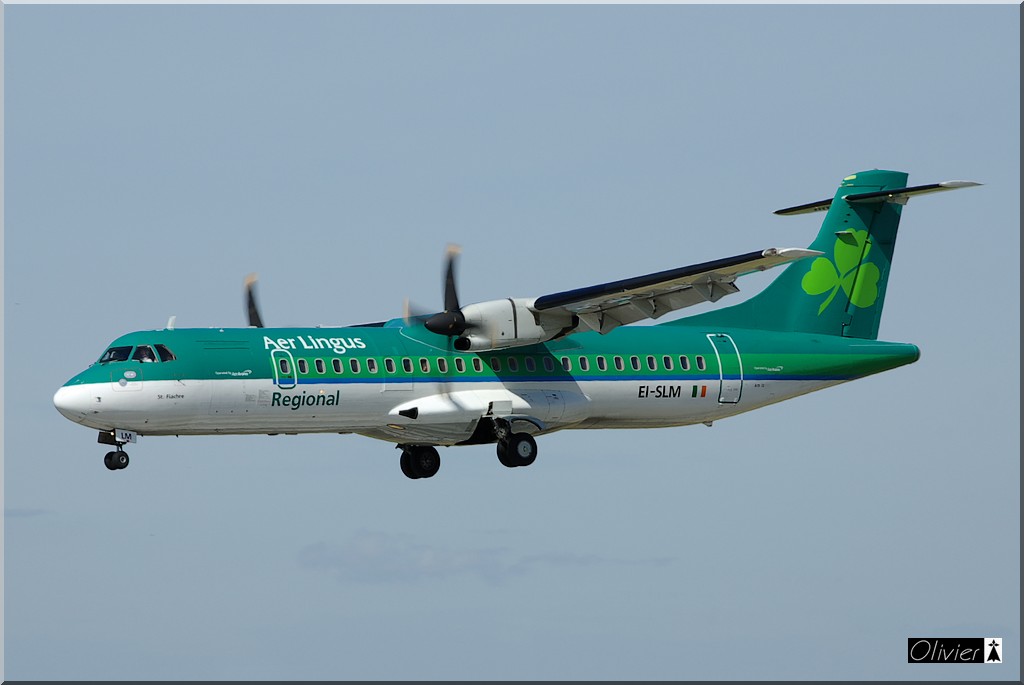
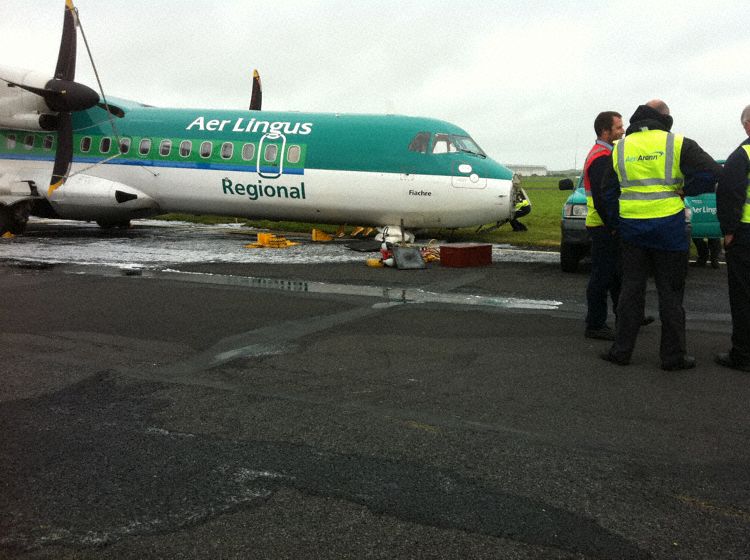


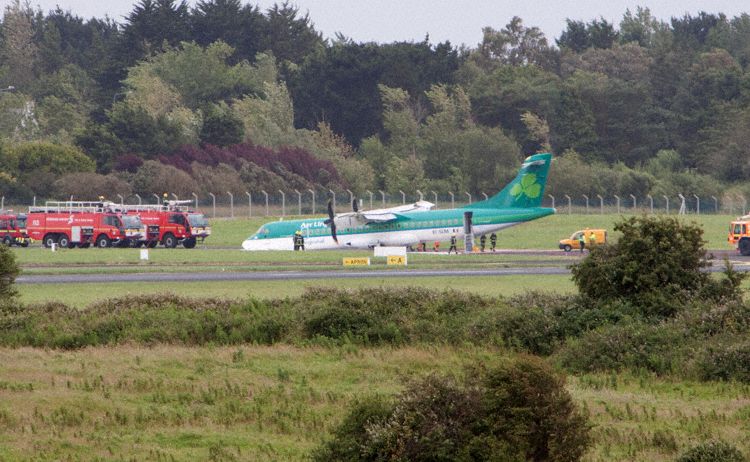
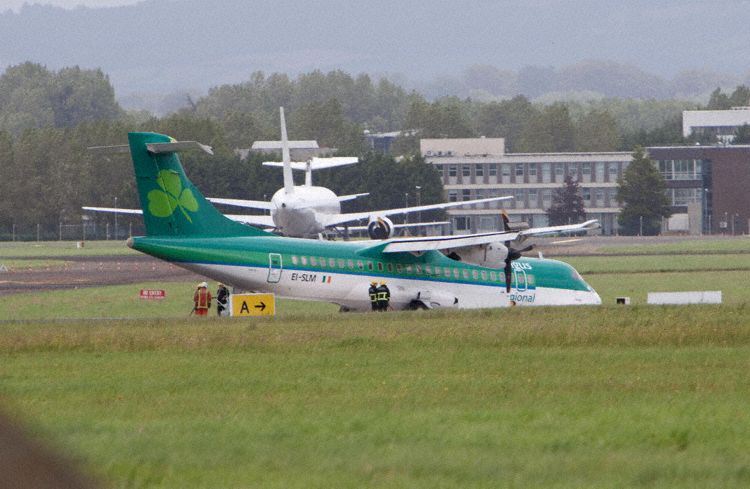
Ground collision of an ATR72-202 in Warsaw
Date & Time:
Jul 14, 2011 at 2230 LT
Registration:
SP-LFH
Survivors:
Yes
Schedule:
Wrocław – Warsaw
MSN:
478
YOM:
1995
Flight number:
ELO3850
Crew on board:
4
Crew fatalities:
Pax on board:
33
Pax fatalities:
Other fatalities:
Total fatalities:
0
Circumstances:
On 14 July, 2011 ATR 72 flight crew after landing at EPWA aerodrome received the clearance for taxiing to parking stand 41 via taxiways: "S", "O" and "M". When the airplane was on taxiway "M2", "Mulag" type tractor was moving by the service road, passing perpendicularly to taxiway “M2”. The tractor driver did not give the right of way to ATR 72 and the tractor collided with the airplane. As a result, the airplane and the tractor sustained substantial damages. The flight crew stopped the airplane and shut down the engines. Airport Fire Brigade and an ambulance were called. The tractor operator suffered some injuries and was taken to hospital. the airplane passengers and the flight crew did not suffer any injuries. The impact caused a fuel leakage from the airplane of 200 m2 in area, which was removed along with other elements of the damaged aircraft by the Airport Fire Brigade. The airplane and the "Mulag" tractor were withdrawn from the further service. During the accident there were adverse weather conditions at the airport - heavy rain and lightning which caused reduction in visibility.
Probable cause:
Inadequate observation of the Ground Movement Area by the “Mulag” tractor operator.
Contributing factors:
1. Heavy rain and lightning.
2. Light reflections on the aerodrome surface which hindered observation from the tractor cab.
3. Construction of the "Mulag” tractor cab, left side of which could partially or completely obscure silhouette of the airplane.
4. Short distance between a service road and taxiway "O2".
Contributing factors:
1. Heavy rain and lightning.
2. Light reflections on the aerodrome surface which hindered observation from the tractor cab.
3. Construction of the "Mulag” tractor cab, left side of which could partially or completely obscure silhouette of the airplane.
4. Short distance between a service road and taxiway "O2".
Final Report:




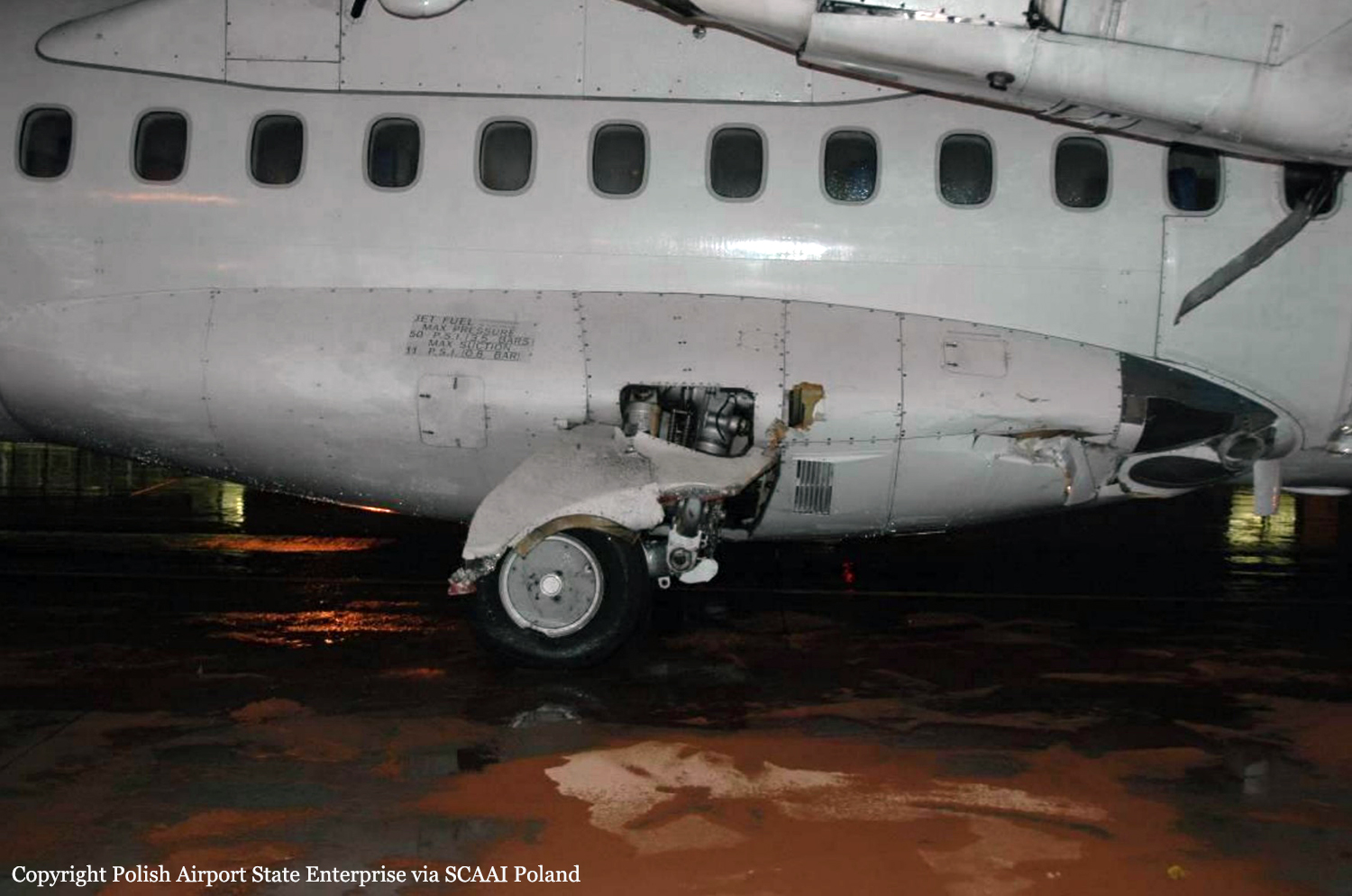
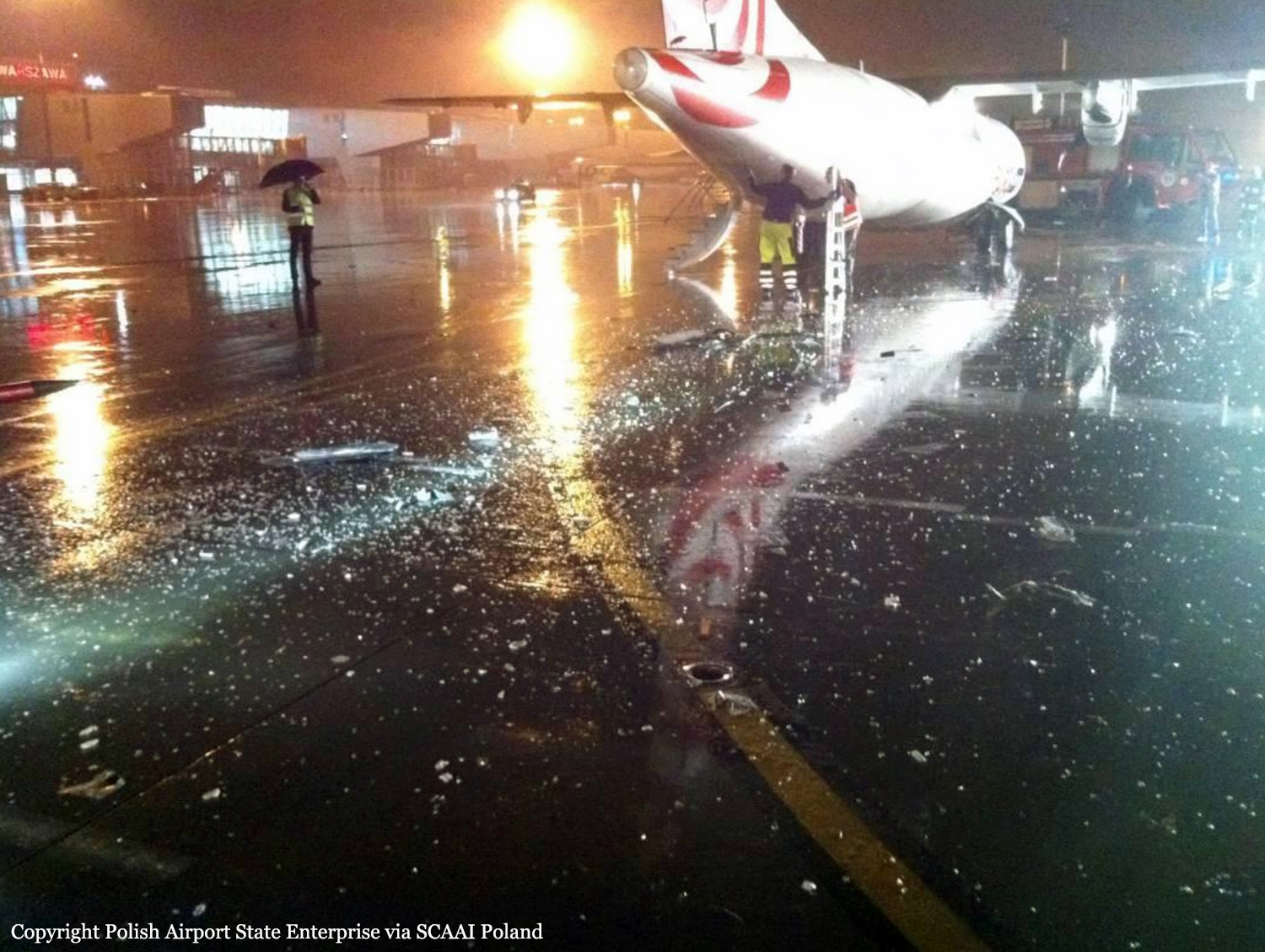
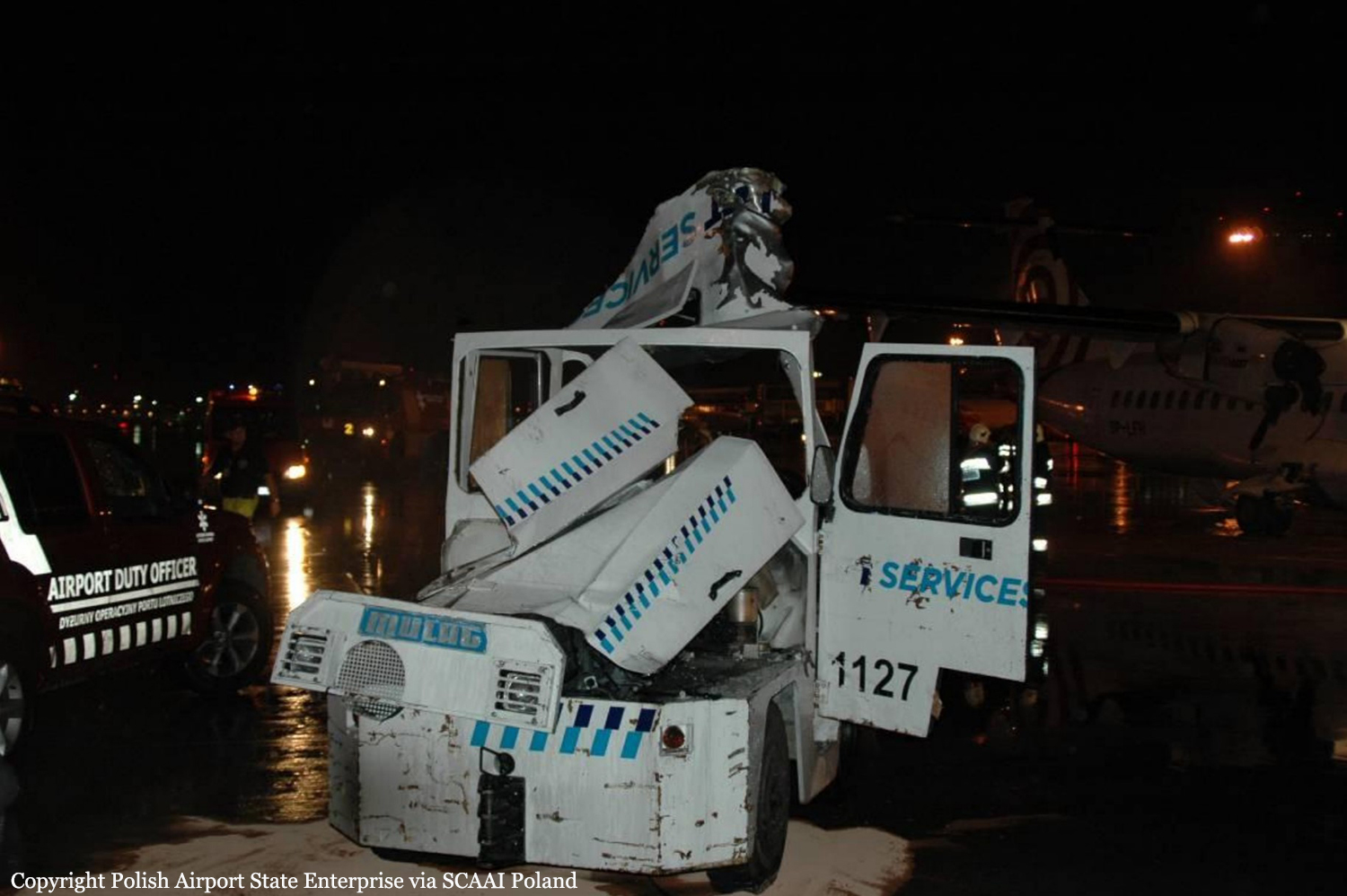
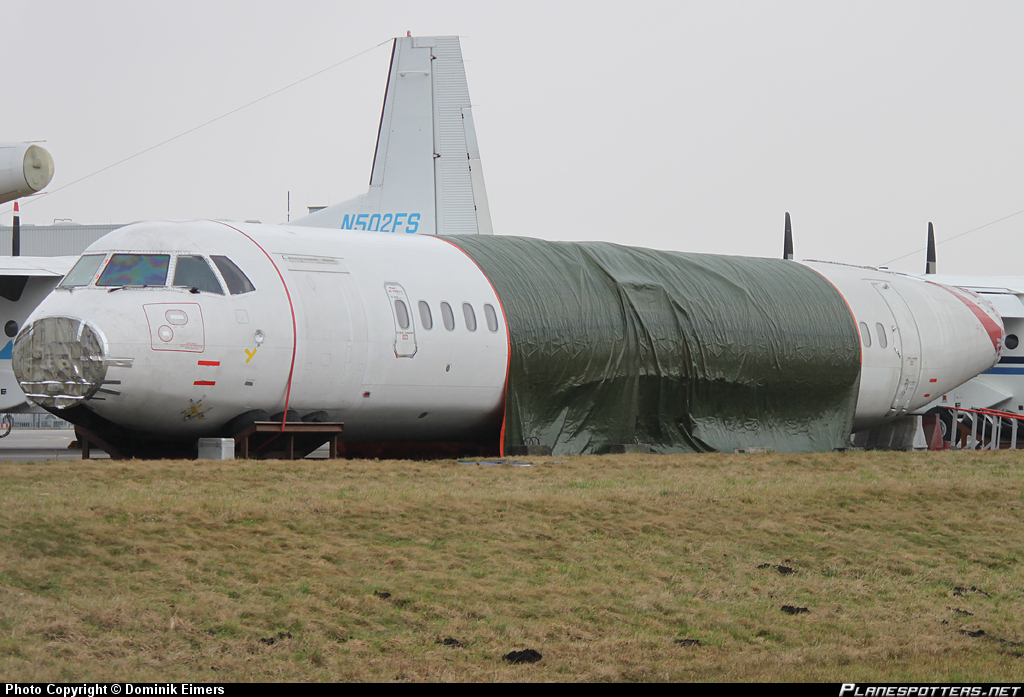
Crash of an ATR72-212 in Altamira
Date & Time:
Feb 21, 2011 at 1845 LT
Registration:
PR-TTI
Survivors:
Yes
Schedule:
Belém - Altamira
MSN:
454
YOM:
1995
Flight number:
TIB5204
Crew on board:
4
Crew fatalities:
Pax on board:
47
Pax fatalities:
Other fatalities:
Total fatalities:
0
Captain / Total hours on type:
2600.00
Copilot / Total hours on type:
50
Aircraft flight hours:
32886
Circumstances:
The aircraft departed Belém-Val de Cans Airport on a schedule service to Altamira with 47 passengers and 4 crew members on board. The approach for landing in Altamira was completed in VFR mode and the aircraft was stabilized. The touchdown on the runway was smooth, with gradual deceleration, in which only the 'ground idle' was used. After the '70 knots' callout, a strong noise was heard, and the left main gear collapsed with the aircraft deviating to the left. The aircraft veered off runway and came to rest in a grassy area. Among the 51 occupants, one passenger suffered minor injuries.
Probable cause:
The following findings were identified:
- The LEFT MAIN LANDING GEAR ASSEMBLY (PN D23189000-19 and SN MN1700) collapsed, failing with 5,130 cycles after the last overhaul.
- A specific component (pin) of the assembly connecting the landing gear to the airframe, the AFT PIVOT PIN (P / N D61000, S / N 25), broke on account of fatigue, whose onset was facilitated by a machining process carried out in the pin section transition region.
- The ANAC-approved ATR72 Series Aircraft Maintenance Program of the TRIP Linhas Aéreas company read that the LEFT MAIN LANDING GEAR ASSEMBLY had to undergo overhaul every eight years or 18,000 cycles.
- On 27 February 2009, the PR-TTI landing gear was removed and, on 09 March 2009, was sent to be overhauled by the AV Indústria Aeronáutica Ltda. It had 31,684 cycles since new and 18,095 cycles since the last overhaul.
- AV Indústria Aeronáutica Ltda. was homologated for conducting such inspection, as specified in the List attached to the Addendum, Revision no. 11, dated 05 January 2009, and accepted by means of the Official Document no. 0173/2009-GGAC/SAR, issued by the Civil Aviation Authority.
- The AV Indústria Aeronáutica Ltda. company disassembled the legs of the landing gear, and outsourced some of the tasks for not possessing technical knowledge and/or appropriate machinery (necessary for the process of reconditioning the AFT PIVOT PIN (D61000 SN 25).
- Two of the three companies outsourced by AV Indústria Aeronáutica Ltda. were not homologated by the Civil Aviation Authority.
- The AV Indústria Aeronáutica Ltda. company conducted external audits of the three companies involved in the overhaul.
- The audits carried out by AV Indústria Aeronáutica Ltda. were not sufficient to identify that the contractors lacked qualified personnel, manuals and the machinery necessary to work with aeronautical products.
- The AV Indústria Aeronáutica Ltda. Technical Manager did not supervise the overhaul inspections and services performed by the contracted companies.
- The AFT PIVOT PIN (D61000 SN 25) is part of the assembly that connects the landing gear to the airframe.
- All revision tasks were described in the manuals of the manufacturer.
- The AFT PIVOT PIN (D61000 SN 25) failure-analysis report stated that the PRTTI aircraft left main landing gear collapsed on account of fatigue, whose onset was facilitated by a machining process carried out in the section transition region of the pin.
- The manufacturer's maintenance manual did not refer to any machining work in that region of the pin.
- In only one stage of the pin reconditioning process was it possible to observe that a machining task was required, namely, the Grinding of chromium.
- The lack of capacitation and training of the subcontractors’ professionals for handling aircraft material hindered the execution of an efficient maintenance work as prescribed by the manufacturer's manual, culminating in inadequate machining during the maintenance process.
- The lack of an effective process of supervision, both on the part of TRIP Linhas Aéreas and on the part of the other contractors and subcontractors allowed the existing maintenance services’ latent failures not to be checked and corrected, in a way capable of subsidizing, in an adequate and safe manner, the execution of the landing gear maintenance service.
- The process of supervision of the TRIP Linhas Aéreas and the AV Indústria Aeronáutica Ltda. companies by the Civil Aviation Authority, prescribed by specific legislation in force, was not enough to mitigate the latent conditions present in the accident in question.
- According to the technical opinion issued by the DCTA, the AFT PIVOT PIN (D61000 and SN 25) presented fracture surfaces with ± 45º inclination, as well as a flat area with multiple initiations, indicative of a fracture mechanism related to fatigue. In examinations of the external surface of the pin, in a region close to the fatigue fracture, cracks were observed that had initiated from scratches created by an inadequate maintenance machining process. In the region where the overload-related fracture occurred, it was also possible to identify that the machining process had modified the profile of the part in the section transition region, by producing a depression. Thus, it can be said that the AFT PIVOT PIN (D61000 and SN 25) of the PR-TTI left main gear broke on account of fatigue, whose onset was facilitated by an inadequate machining process that had been performed in the section transition region of the pin.
- The LEFT MAIN LANDING GEAR ASSEMBLY (PN D23189000-19 and SN MN1700) collapsed, failing with 5,130 cycles after the last overhaul.
- A specific component (pin) of the assembly connecting the landing gear to the airframe, the AFT PIVOT PIN (P / N D61000, S / N 25), broke on account of fatigue, whose onset was facilitated by a machining process carried out in the pin section transition region.
- The ANAC-approved ATR72 Series Aircraft Maintenance Program of the TRIP Linhas Aéreas company read that the LEFT MAIN LANDING GEAR ASSEMBLY had to undergo overhaul every eight years or 18,000 cycles.
- On 27 February 2009, the PR-TTI landing gear was removed and, on 09 March 2009, was sent to be overhauled by the AV Indústria Aeronáutica Ltda. It had 31,684 cycles since new and 18,095 cycles since the last overhaul.
- AV Indústria Aeronáutica Ltda. was homologated for conducting such inspection, as specified in the List attached to the Addendum, Revision no. 11, dated 05 January 2009, and accepted by means of the Official Document no. 0173/2009-GGAC/SAR, issued by the Civil Aviation Authority.
- The AV Indústria Aeronáutica Ltda. company disassembled the legs of the landing gear, and outsourced some of the tasks for not possessing technical knowledge and/or appropriate machinery (necessary for the process of reconditioning the AFT PIVOT PIN (D61000 SN 25).
- Two of the three companies outsourced by AV Indústria Aeronáutica Ltda. were not homologated by the Civil Aviation Authority.
- The AV Indústria Aeronáutica Ltda. company conducted external audits of the three companies involved in the overhaul.
- The audits carried out by AV Indústria Aeronáutica Ltda. were not sufficient to identify that the contractors lacked qualified personnel, manuals and the machinery necessary to work with aeronautical products.
- The AV Indústria Aeronáutica Ltda. Technical Manager did not supervise the overhaul inspections and services performed by the contracted companies.
- The AFT PIVOT PIN (D61000 SN 25) is part of the assembly that connects the landing gear to the airframe.
- All revision tasks were described in the manuals of the manufacturer.
- The AFT PIVOT PIN (D61000 SN 25) failure-analysis report stated that the PRTTI aircraft left main landing gear collapsed on account of fatigue, whose onset was facilitated by a machining process carried out in the section transition region of the pin.
- The manufacturer's maintenance manual did not refer to any machining work in that region of the pin.
- In only one stage of the pin reconditioning process was it possible to observe that a machining task was required, namely, the Grinding of chromium.
- The lack of capacitation and training of the subcontractors’ professionals for handling aircraft material hindered the execution of an efficient maintenance work as prescribed by the manufacturer's manual, culminating in inadequate machining during the maintenance process.
- The lack of an effective process of supervision, both on the part of TRIP Linhas Aéreas and on the part of the other contractors and subcontractors allowed the existing maintenance services’ latent failures not to be checked and corrected, in a way capable of subsidizing, in an adequate and safe manner, the execution of the landing gear maintenance service.
- The process of supervision of the TRIP Linhas Aéreas and the AV Indústria Aeronáutica Ltda. companies by the Civil Aviation Authority, prescribed by specific legislation in force, was not enough to mitigate the latent conditions present in the accident in question.
- According to the technical opinion issued by the DCTA, the AFT PIVOT PIN (D61000 and SN 25) presented fracture surfaces with ± 45º inclination, as well as a flat area with multiple initiations, indicative of a fracture mechanism related to fatigue. In examinations of the external surface of the pin, in a region close to the fatigue fracture, cracks were observed that had initiated from scratches created by an inadequate maintenance machining process. In the region where the overload-related fracture occurred, it was also possible to identify that the machining process had modified the profile of the part in the section transition region, by producing a depression. Thus, it can be said that the AFT PIVOT PIN (D61000 and SN 25) of the PR-TTI left main gear broke on account of fatigue, whose onset was facilitated by an inadequate machining process that had been performed in the section transition region of the pin.
Final Report:




Crash of an ATR72-212 in Guasimal: 68 killed
Date & Time:
Nov 4, 2010 at 1751 LT
Registration:
CU-T1549
Survivors:
No
Schedule:
Port-au-Prince - Santiago de Cuba - Havana
MSN:
459
YOM:
1995
Flight number:
CRN883
Crew on board:
7
Crew fatalities:
Pax on board:
61
Pax fatalities:
Other fatalities:
Total fatalities:
68
Aircraft flight hours:
25000
Aircraft flight cycles:
34500
Circumstances:
The twin engine aircraft departed Port-au-Prince on a schedule service to Havana with an intermediate stop in Santiago de Cuba, carrying 61 passengers and 7 crew members. The airplane departed Santiago de Cuba-Antonio Maceo Airport at 1644LT and the crew was cleared to climb to his assigned altitude of 18,000 feet. At 1736LT, the crew was cleared to climb to 20,000 feet. During the climb, the Total Air Temperature (TAT) dropped from +3°C to -1°C and the aircraft' speed dropped from 196 knots to 176 knots. At 17:44, at FL200, the ICING caution light illuminated on the instrument panel with an associated chime. This was followed by the illumination of the AOA light several seconds later. At 17:46 the crew toggled the anti-icing switches on the overhead panel and contacted Havana Control to request permission to descent to FL160 due to icing. However, the controller reported conflicting traffic 30 miles ahead. The crew then requested vectors to enable them to descend. Clearance was given to change course from 295° to 330°. At 17:49, with an airspeed of 156 kts, the airplane commenced a right bank. Then suddenly the airplane banked left and right before banking 90° to the left again with a steep nose down attitude. The crew struggled to control the plane, which was banking turning and losing altitude. Out of control, the aircraft crashed in a wooded an hilly terrain. All 68 occupants were killed.
Probable cause:
Flight was proceeding normally until it found itself in extreme meteorological conditions that caused the airplane to ice up severely at an altitude of 20,000ft (6,100m). This, in conjunction with errors by the crew in managing the situation, caused the accident.
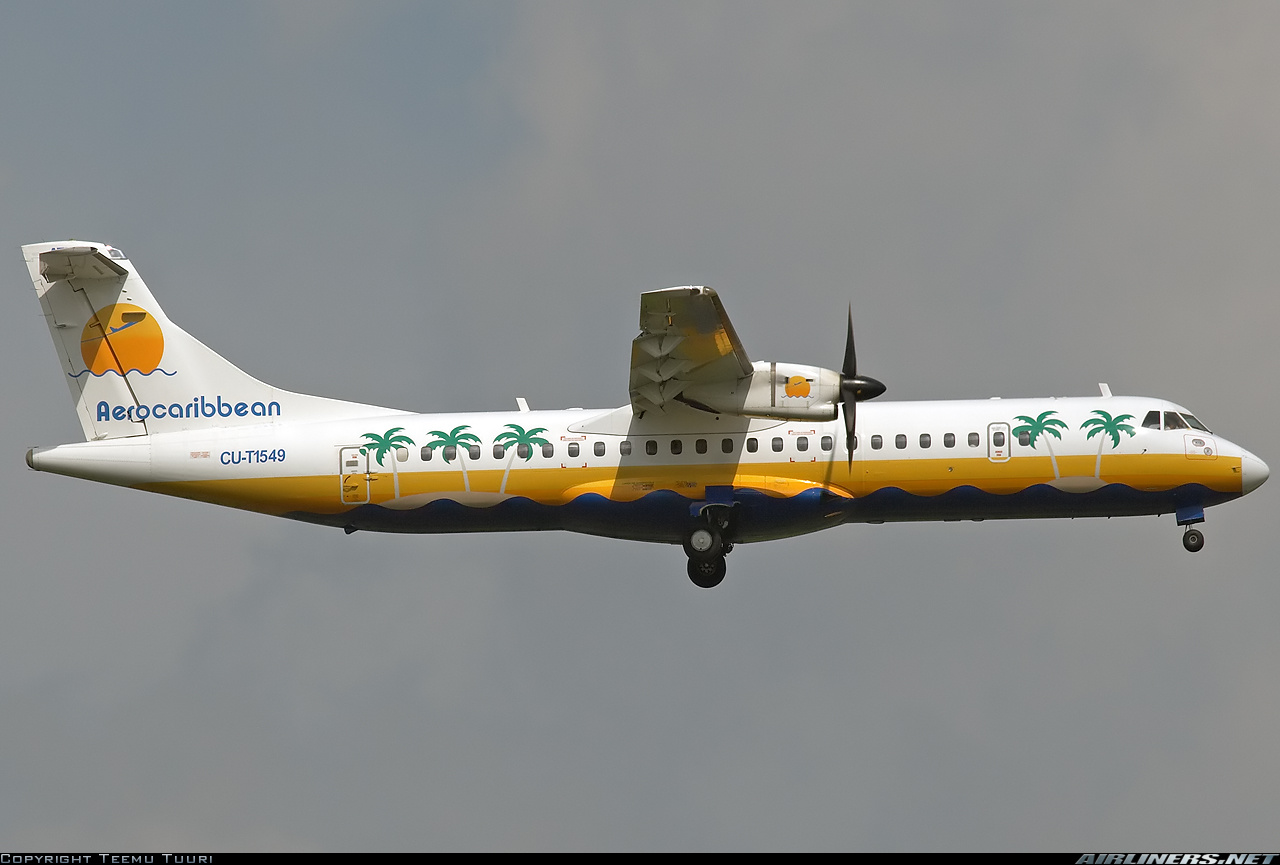
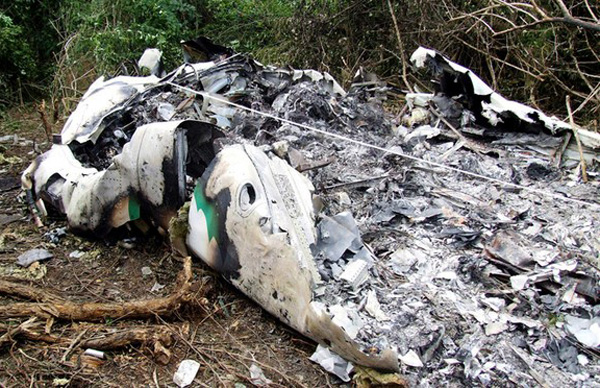
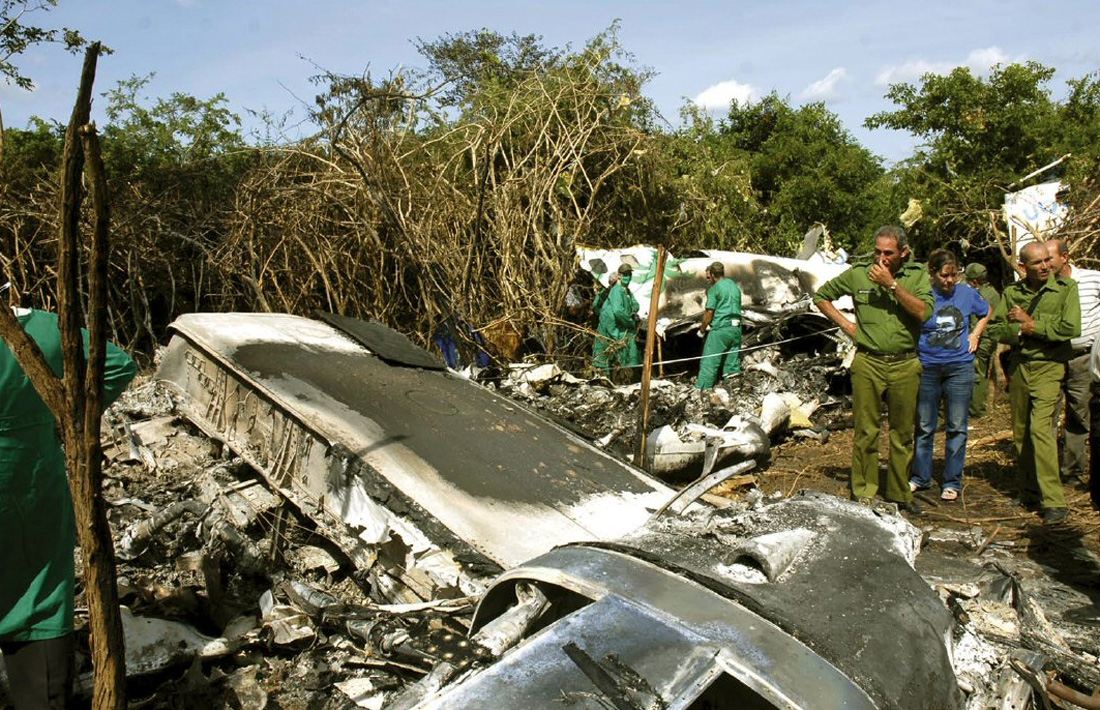

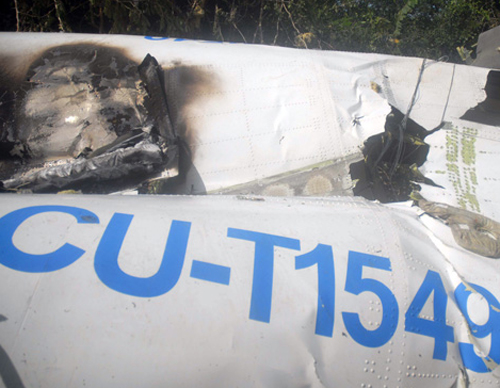
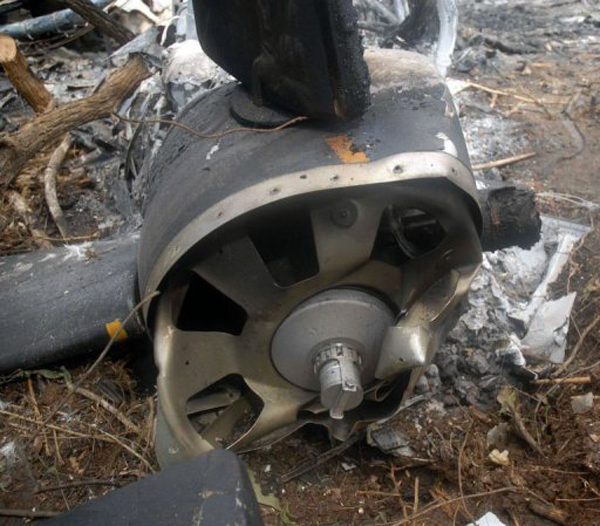
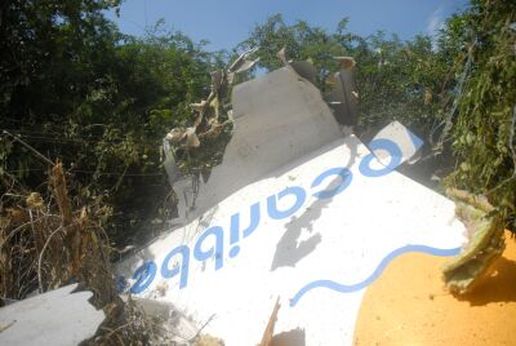
Crash of an ATR72-212A in Manila
Date & Time:
Jul 28, 2010 at 1515 LT
Registration:
RP-C7254
Survivors:
Yes
Schedule:
Tuguegarao – Manila
MSN:
828
YOM:
2008
Flight number:
5J509
Crew on board:
0
Crew fatalities:
Pax on board:
0
Pax fatalities:
Other fatalities:
Total fatalities:
0
Circumstances:
Cebu Pacific Air flight 5J509, an ATR 72-500, took off from Tuguegarao Airport, Philippines, bound for Manila-Ninoy Aquino International Airport. The first officer was the Pilot Flying (PF) while the captain was the Pilot Not Flying (PNF). Approaching Manila, the flight was under radar vector for a VOR/DME approach to runway 24. At 7 miles on finals the approach was stabilized. A sudden tailwind was experienced by the crew at 500 feet radio altitude (RA) which resulted in an increase in airspeed and vertical speed. The captain took over the controls and continued the approach. Suddenly, the visibility went to zero and consequently the aircraft experienced a bounced landing three times, before a go-around was initiated. During climb out the crew noticed cockpit instruments were affected including both transponders and landing gears. They requested for a priority landing and were vectored and cleared to land on runway 13. After landing the aircraft was taxied to F4 where normal deplaning was carried out. No injuries were reported on the crew and passengers.
Probable cause:
Primary Cause Factor:
- Failure of the flight crew to discontinue the approach when deteriorating weather and their associated hazards to flight operations had moved into the airport (Human Factor)
Contributory Factor:
- The adverse weather condition affected the judgment and decision-making of the PIC even prior to the approach to land. With poor weather conditions being encountered, the PIC still continued the approach and landing. (Environmental Factor)
Underlying Factor:
- As a result of the bounced landing, several cockpit instruments were affected including both transponders on board. One of the nosewheels was detached and all the landing gears could not be retracted. Further, the integrity of the structure may have been affected and chance airframe failure was imminent. With all of these conditions, the Captain still opted to request for a priority landing when emergency landing was needed.
- Failure of the flight crew to discontinue the approach when deteriorating weather and their associated hazards to flight operations had moved into the airport (Human Factor)
Contributory Factor:
- The adverse weather condition affected the judgment and decision-making of the PIC even prior to the approach to land. With poor weather conditions being encountered, the PIC still continued the approach and landing. (Environmental Factor)
Underlying Factor:
- As a result of the bounced landing, several cockpit instruments were affected including both transponders on board. One of the nosewheels was detached and all the landing gears could not be retracted. Further, the integrity of the structure may have been affected and chance airframe failure was imminent. With all of these conditions, the Captain still opted to request for a priority landing when emergency landing was needed.








